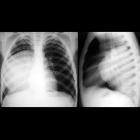hydatid cyst

























































Hydatid cysts result from infection by the Echinococcus tapeworm species and can result in cyst formation anywhere in the body.
Epidemiology
Cystic echinococcosis has a worldwide geographical distribution. The Mediterranean basin is an important endemic area .
Pathology
There are two main species of the Echinococcus tapeworm :
- Echinococcus granulosus
- more common
- pastoral: the dog is the main host; most common form
- sylvatic: the wolf is the main host
- Echinococcus alveolaris/multilocularis
- less common but more invasive
- fox is the main host
Definitive hosts are carnivores (e.g. dogs, foxes, cats), and the intermediate hosts are most commonly sheep. Humans are accidental hosts, and the infection occurs by ingesting food contaminated with Echinococcus eggs .
Cyst structure
The cysts usually have three components :
- pericyst: composed of inflammatory tissue of host origin
- exocyst
- endocyst: scolices (the larval stage of the parasite) and the laminated membrane are produced here
Cyst classification
Based on morphology the cyst can be classified into four different types :
- type I: simple cyst with no internal architecture
- type II: cyst with daughter cyst(s) and matrix
- type IIa: round daughter cysts at the periphery
- type IIb: larger, irregularly shaped daughter cysts occupying almost the entire volume of the mother cyst
- type IIc: oval masses with scattered calcifications and occasional daughter cysts
- type III: calcified cyst (dead cyst)
- type IV: complicated cyst, e.g. ruptured cyst
For hepatic hydatid infection on ultrasound also refer to World Health Organization 2001 classification of hepatic hydatid cysts.
Location
- hepatic hydatid infection: most common organ (76% of cases)
- pulmonary hydatid infection: second most common organ (15% of cases)
- splenic hydatid infection: third most common organ (5% of cases)
- cerebral hydatid infection
- spinal hydatid infection
- retroperitoneal hydatid infection
- renal hydatid infection
- musculoskeletal hydatid infection
- mediastinal hydatid infection (very rare)
Markers
Radiographic features
A chest film or other plain films can be the first diagnostic modality when echinococcosis is suspected, depending on clinical indications.
CT and MRI imaging are indicated when considering surgical treatment, particularly in regions like the brain, spine, and locations inaccessible for conventional radiography or ultrasound, or in case of diagnostic uncertainty.
Ultrasound
The Gharbi ultrasound classification consists of five stages:
- stage 1: homogeneously hypoechogenic cystic thin-walled lesion
- stage 2: septated cystic lesion
- stage 3: cystic lesion with daughter lesions
- stage 4: pseudo-tumor lesion
- stage 5: calcified or partially calcified lesion (inactive cyst)
Treatment and prognosis
Four treatment options are currently available :
- surgical excision
- PAIR (Puncture, Aspiration, Injection of protoscolicidal agent and Reaspiration)
- chemotherapy with an anti-helminthic agent (albendazole, mebendazole)
- watch and wait for inactive and silent cysts
Treatment outcomes were improved when surgery or PAIR was combined with benzimidazole given before and after surgery . Regarding medical management, higher scolicidal and anti-cystic activity was seen in combination therapy with albendazole plus praziquantel and was more likely to result in cure or improvement .
Siehe auch:
- Echinococcus Leber
- Echinokokkose der Lunge
- Echinokokkose der Niere
- Echinokokkose der Milz
- intrakranielle Echinokokkose
- retroperitoneal hydatid infection
- rupturierte Echinokokkuszyste
- muskuloskelettale Bandwurmerkrankung
- percutaneous treatment of hydatid cyst
- mesenteriale Echinokokkose
und weiter:
- Pneumatozele
- Splenomegalie
- Luftsichelzeichen
- vegetable and plant inspired signs
- Wasserlilien-Zeichen
- hydatid cyst signs
- differential of an air crescent sign
- Echinokokkose des Hodens
- Knochenläsionen der Diaphyse
- hydatid disease with thyroid, abdominal wall and kidney involvement
- verkalkte Echinokokkuszysten
- hydatid disease with hepatic, osseous and muscular involvement
- hydatid
- thyroid hydatid disease
- hepatic vein thrombosis in hepatic echinococcosis alveolaris
- intraventrikuläre Echinokokkuszysten
- mesenteric hydatid cysts
- hydatid cyst of the mediastinum
- eingeblutete Echinokokkuszyste der Leber
- Ruptur einer Echinokokkuszyste der Leber in die Gallenwege
- Echinococcuszyste Pankreas
- zervikale Echinokokkose
- Echinokokkose der Nebennieren
- intrakardiale Echinokokkuszysten

 Assoziationen und Differentialdiagnosen zu Echinokokkose:
Assoziationen und Differentialdiagnosen zu Echinokokkose:




